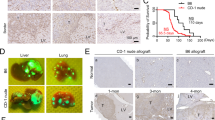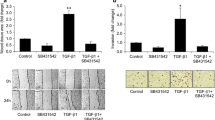Abstract
Cholangiocarcinoma morbidity and mortality is attributable to local invasiveness and regional lymph node and distant organ metastasis. Cholangiocarcinoma progression follows a series of sequential events that resemble wound healing reactions: local invasion resembles the epithelial migration phase involving epithelial–mesenchymal transition (EMT); colonization at distant sites resembles epithelial restitution seen during the reverse process, mesenchymal–epithelial transition (MET). In this study we compare the in vivo local and metastatic growth potential of cholangiocarcinoma cell lines with respect to expression of a novel pSTAT3-dependent, biliary epithelial cell wound healing protein, small proline-rich protein 2A (SPRR2A). SPRR2A has been associated with local aggressiveness, but decreased metastatic capabilities in other cancers. Stable SPRR2A transfection into two cholangiocarcinoma cell lines (SG231 and HuCCT-1), previously shown by us to induce permanent EMT, resulted in local aggressiveness but an inability to form metastases. In contrast, SPRR2A-negative epithelial control cells showed relatively poor local aggressiveness, but readily formed metastatic tumors. Post-intrasplenic injection cell tracking showed that: (a) mesenchymal (SPRR2A+) cells were not trapped in the liver, but were rapidly cleared through mesenteric lymph nodes and did not form metastases; whereas (b) epithelial (SPRR2A−) controls were primarily entrapped within MUC-1-associated liver “micro-infarcts” that later evolved into metastatic colonies. SPRR2A-associated tumor behavior was mimicked by MUC1 shRNA, which induced EMT and, like SPRR2A+ cells, showed reduced metastatic capabilities. Cholangiocarcinoma local invasion involves EMT processes, whereas MET and MUC1 expression promote metastasis. A better understanding of disease progression should help target treatment for this deadly neoplasm.







Similar content being viewed by others
Abbreviations
- BEC:
-
Biliary epithelial cells
- EMT:
-
Epithelial–mesenchymal transition
- MET:
-
Mesenchymal–epithelial transition
- MUC1:
-
Mucin 1
- ROS:
-
Reactive oxygen species
- SPRR2A:
-
Small proline-rich protein 2A
References
Nozaki I, Lunz JG 3rd, Specht S et al (2005) Small proline-rich proteins 2 are noncoordinately upregulated by IL-6/STAT3 signaling after bile duct ligation. Lab Invest 85(1):109–123
Demetris AJ, Lunz JG 3rd, Specht S et al (2006) Biliary wound healing, ductular reactions, and IL-6/gp130 signaling in the development of liver disease. World J Gastroenterol 12(22):3512–3522
Demetris AJ, Specht S, Nozaki I et al (2008) Small proline-rich proteins (SPRR) function as SH3 domain ligands, increase resistance to injury and are associated with epithelial-mesenchymal transition (EMT) in cholangiocytes. J Hepatol 48(2):276–288
Cabral A, Voskamp P, Cleton-Jansen AM et al (2001) Structural organization and regulation of the small proline-rich family of cornified envelope precursors suggest a role in adaptive barrier function. J Biol Chem 276(22):19231–19237
Vermeij WP, Alia A, Backendorf C (2011) ROS quenching potential of the epidermal cornified cell envelope. J Invest Dermatol 131(7):1435–1441
Vermeij WP, Backendorf C (2010) Skin cornification proteins provide global link between ROS detoxification and cell migration during wound healing. PLoS ONE 5(8):e11957
Vermeij WP, Florea BI, Isenia S et al (2012) Proteomic identification of in vivo interactors reveals novel function of skin cornification proteins. J Proteome Res. doi:10.1021/pr300310b
Schafer M, Werner S (2008) Cancer as an overhealing wound: an old hypothesis revisited. Nat Rev Mol Cell Biol 9(8):628–638
Yao D, Dai C, Peng S (2011) Mechanism of the mesenchymal-epithelial transition and its relationship with metastatic tumor formation. Mol Cancer Res 9(12):1608–1620
Sano S, Itami S, Takeda K et al (1999) Keratinocyte-specific ablation of Stat3 exhibits impaired skin remodeling, but does not affect skin morphogenesis. EMBO J 18(17):4657–4668
Chiarle R, Simmons WJ, Cai H et al (2005) Stat3 is required for ALK-mediated lymphomagenesis and provides a possible therapeutic target. Nat Med 11(6):623–629
Darnell JE Jr (2002) Transcription factors as targets for cancer therapy. Nat Rev Cancer 2(10):740–749
Lassmann S, Schuster I, Walch A et al (2007) STAT3 mRNA and protein expression in colorectal cancer: effects on STAT3-inducible targets linked to cell survival and proliferation. J Clin Pathol 60(2):173–179
Masuda M, Suzui M, Yasumatu R et al (2002) Constitutive activation of signal transducers and activators of transcription 3 correlates with cyclin D1 overexpression and may provide a novel prognostic marker in head and neck squamous cell carcinoma. Cancer Res 62(12):3351–3355
Niu G, Wright KL, Huang M et al (2002) Constitutive Stat3 activity up-regulates VEGF expression and tumor angiogenesis. Oncogene 21(13):2000–2008
Li L, Shaw PE (2004) A STAT3 dimer formed by inter-chain disulphide bridging during oxidative stress. Biochem Biophys Res Commun 322(3):1005–1011
Waris G, Ahsan H (2006) Reactive oxygen species: role in the development of cancer and various chronic conditions. J Carcinog 5:14
auf dem Keller U, Kumin A, Braun S et al (2006) Reactive oxygen species and their detoxification in healing skin wounds. J Investig Dermatol Symp Proc 11(1):106–111
Li C, Jackson RM (2002) Reactive species mechanisms of cellular hypoxia-reoxygenation injury. Am J Physiol Cell Physiol 282(2):C227–C241
Terui K, Enosawa S, Haga S et al (2004) Stat3 confers resistance against hypoxia/reoxygenation-induced oxidative injury in hepatocytes through upregulation of Mn-SOD. J Hepatol 41(6):957–965
Mizuguchi Y, Specht S, Lunz JG 3rd et al (2012) Cooperation of p300 and PCAF in the control of microRNA 200c/141 transcription and epithelial characteristics. PLoS One 7(2):e32449
Mizuguchi Y, Specht S, Lunz JG 3rd et al (2012) SPRR2a enhances p53 deacetylation through HDAC1 and down regulates p21 promoter activity. BMC Mol Biol 13(1):20
Kim JC, Yu JH, Cho YK et al (2012) Expression of SPRR3 is associated with tumor cell proliferation in less advanced stages of breast cancer. Breast Cancer Res Treat 133(3):909–916
Hippo Y, Yashiro M, Ishii M et al (2001) Differential gene expression profiles of scirrhous gastric cancer cells with high metastatic potential to peritoneum or lymph nodes. Cancer Res 61(3):889–895
Chen BS, Wang MR, Cai Y et al (2000) Decreased expression of SPRR3 in Chinese human oesophageal cancer. Carcinogenesis 21(12):2147–2150
Tomayko MM, Reynolds CP (1989) Determination of subcutaneous tumor size in athymic (nude) mice. Cancer Chemother Pharmacol 24(3):148–154
Yokomuro S, Tsuji H, Lunz JG 3rd et al (2000) Growth control of human biliary epithelial cells by interleukin 6, hepatocyte growth factor, transforming growth factor beta1, and activin A: comparison of a cholangiocarcinoma cell line with primary cultures of non-neoplastic biliary epithelial cells. Hepatology 32(1):26–35
Han C, Leng J, Demetris AJ et al (2004) Cyclooxygenase-2 promotes human cholangiocarcinoma growth: evidence for cyclooxygenase-2-independent mechanism in celecoxib-mediated induction of p21waf1/cip1 and p27kip1 and cell cycle arrest. Cancer Res 64(4):1369–1376
Walker JA, Kilroy GE, Xing J et al (2003) Human DNA quantitation using Alu element-based polymerase chain reaction. Anal Biochem 315(1):122–128
Suh KS, Roh HR, Koh YT et al (2000) Clinicopathologic features of the intraductal growth type of peripheral cholangiocarcinoma. Hepatology 31(1):12–17
Giavazzi R, Jessup JM, Campbell DE et al (1986) Experimental nude mouse model of human colorectal cancer liver metastases. J Natl Cancer Inst 77(6):1303–1308
Hollingsworth MA, Swanson BJ (2004) Mucins in cancer: protection and control of the cell surface. Nat Rev Cancer 4(1):45–60
Varki A (2007) Trousseau’s syndrome: multiple definitions and multiple mechanisms. Blood 110(6):1723–1729
Guaita S, Puig I, Franci C et al (2002) Snail induction of epithelial to mesenchymal transition in tumor cells is accompanied by MUC1 repression and ZEB1 expression. J Biol Chem 277(42):39209–39216
Andrianifahanana M, Moniaux N, Batra SK (2006) Regulation of mucin expression: mechanistic aspects and implications for cancer and inflammatory diseases. Biochim Biophys Acta 1765(2):189–222
Gao J, McConnell MJ, Yu B et al (2009) MUC1 is a downstream target of STAT3 and regulates lung cancer cell survival and invasion. Int J Oncol 35(2):337–345
Sachdeva M, Mo YY (2010) MicroRNA-145 suppresses cell invasion and metastasis by directly targeting mucin 1. Cancer Res 70(1):378–387
Thiery JP, Acloque H, Huang RY et al (2009) Epithelial-mesenchymal transitions in development and disease. Cell 139(5):871–890
Barriere G, Tartary M, Rigaud M (2012) Epithelial mesenchymal transition: a new insight into the detection of circulating tumor cells. ISRN Oncol 2012:382010
Chaffer CL, Brennan JP, Slavin JL et al (2006) Mesenchymal-to-epithelial transition facilitates bladder cancer metastasis: role of fibroblast growth factor receptor-2. Cancer Res 66(23):11271–11278
Tsuji T, Ibaragi S, Hu GF (2009) Epithelial-mesenchymal transition and cell cooperativity in metastasis. Cancer Res 69(18):7135–7139
Klerk CP, Smorenburg SM, Otten HM et al (2005) The effect of low molecular weight heparin on survival in patients with advanced malignancy. J Clin Oncol 23(10):2130–2135
Moggs JG, Tinwell H, Spurway T et al (2004) Phenotypic anchoring of gene expression changes during estrogen-induced uterine growth. Environ Health Perspect 112(16):1589–1606
Gaemers IC, Vos HL, Volders HH et al (2001) A stat-responsive element in the promoter of the episialin/MUC1 gene is involved in its overexpression in carcinoma cells. J Biol Chem 276(9):6191–6199
Horn G, Gaziel A, Wreschner DH et al (2009) ERK and PI3 K regulate different aspects of the epithelial to mesenchymal transition of mammary tumor cells induced by truncated MUC1. Exp Cell Res 315(8):1490–1504
Roy LD, Sahraei M, Subramani DB et al (2011) MUC1 enhances invasiveness of pancreatic cancer cells by inducing epithelial to mesenchymal transition. Oncogene 30(12):1449–1459
Bozkaya G, Korhan P, Cokakli M et al (2012) Cooperative interaction of MUC1 with the HGF/c-Met pathway during hepatocarcinogenesis. Mol Cancer 11(1):64
Acknowledgments
This work was funded by NIH DK49615-07 and the Thomas E. Starzl Transplant Endowment Fund (AJD). STR cell line profiling was done by the University of Pittsburgh Cell Culture and Cytogenetics Facility.
Author information
Authors and Affiliations
Corresponding author
Electronic supplementary material
Below is the link to the electronic supplementary material.
10585_2013_9589_MOESM1_ESM.tif
Supplementary material 1 (Fig. 1) SPRR2A expression down-regulated MUC1 in HuCCT-1 cells. AEC staining (red) for MUC1 shows vector cells express more MUC1 that SPRR2A cells (TIFF 5301 kb)
10585_2013_9589_MOESM2_ESM.tif
Supplementary material 2 (Fig. 2) Only epithelial SG231 vector cells establish tumors in the spleen (black arrows) following post-intrasplenic injection. Real time PCR for the Yb8 Alu human repeat sequence in DNA extracted from the spleens indicates no micro-metastasis present in spleens from animals receiving mesenchymal SPRR2A cell injections. Animals were given 8 weeks for tumor development unless otherwise indicated. The presence of tumor (>10 pg DNA) relative to cell type (vector vs clone) achieved significance (p = 0.02); Fisher’s Exact Test. (# = >10 pg Alu/100 ng total DNA; * autopsied at 12 weeks post-intrasplenic injection) (TIFF 16638 kb)
10585_2013_9589_MOESM3_ESM.tif
Supplementary material 3 (Fig. 3) Epithelial HuCCT-1 vector cells were more successful at establishing tumors following post-intrasplenic injection than SPRR2A transfectants. Real time PCR for the Yb8 Alu human repeat sequence in DNA extracted from various organs showed that epithelial vector cells more readily established tumor burden in the liver, spleen and pancreas than mesenchymal SPRR2A cells. Animals were given 16 weeks for tumor development unless otherwise indicated. The presence of tumor (>10 pg DNA) relative to cell type (vector vs clone) achieved significance in the liver (p = 0.03) and spleen (p = 0.02); Fisher’s Exact Test. (* = >10 pg human DNA/100 ng total DNA) (TIFF 21120 kb)
10585_2013_9589_MOESM4_ESM.tif
Supplementary material 4 (Fig. 4) Knock-down of MUC1 in SG231 vector cells causes EMT. Epithelial SG231 vector cells (GFP+) were stably transfected with MUC1 shRNA (RFP+), resulting in epithelial-to-mesenchymal phenotypic transition and reduced E-cadherin expression. (Hsp-90α = loading control; Western blots quantified using ImageJ analysis) (TIFF 12947 kb)
Rights and permissions
About this article
Cite this article
Specht, S., Isse, K., Nozaki, I. et al. SPRR2A expression in cholangiocarcinoma increases local tumor invasiveness but prevents metastasis. Clin Exp Metastasis 30, 877–890 (2013). https://doi.org/10.1007/s10585-013-9589-2
Received:
Accepted:
Published:
Issue Date:
DOI: https://doi.org/10.1007/s10585-013-9589-2




